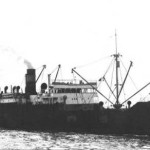When the United States entered World War II in December 1941, it did not take long for Hitler’s U-boats to bring the war to America’s shores. During the first eight months of 1942, U-boats sank more than 600 Allied ships off the East coast and in the Caribbean, before U.S. defenses stiffened. Partly as a consequence of this experience, when British Prime Minister Winston Churchill met with President Franklin Roosevelt in Casablanca in January, 1943, they agreed that war against the U-boats should be a top priority.
That same month, a change in command in Germany would mark the beginning of a long, slow decline in the Nazi submarine threat through the remainder of the war. Adolf Hitler promoted Karl Doenitz, the U-boat fleet commander, to Grand Admiral of the German Navy. Day-to-day command of the submarine fleet passed to Doenitz’s chief of staff, who lacked his boss’s strategic foresight and never gained the unquestioned loyalty of U-boat captains that Doenitz enjoyed.
Several developments began turning the tide of the naval war by mid-1943. The extended range of Allied aircraft meant that U-boats could no longer act with impunity in the mid-Atlantic. Airborne radar, which the Nazis did not think possible, gave Allied planes the opportunity to attack U-boats on the ocean’s surface at night. Improvements in high frequency direction-finding allowed the Allies to locate U-boats whenever they were in communications with their headquarters.
The Allied surface navies benefitted from advances in weaponry and improved tactics. The Hedgehog system fired depth charges in a circular pattern ahead of a suspected U-boat’s anticipated course. Certain charges detonated on contact, while others were time-fused so that even a near miss might explode and damage a U-boat enough to bring it to the surface.
New tactics created special convoy escort groups that began deploying in April of 1943. They consisted of up to ten anti-submarine warships operating in concert with an aircraft carrier and became known as “hunter-killer” groups. Once a U-boat was detected, using sonar, radio frequencies or aerial spotting, a number of the group’s warships would be dispatched to stay on top of the submarine until it had to come to the surface, where it was no match for the firepower of the ships that awaited it.
The hunters had become the hunted.
Following D-day and the invasion of France, the Allies lost 24 merchant ships from September through December of 1944. In that same period, Germany lost 55 U-boats.
From Sept. 3, 1939, to May 8, 1945, roughly 39,000 men took part in U-boat combat operations; 27,500 of those men never returned. U-boats accounted for about 2,700 merchant ships sunk during the war, more than one ship for every day of the war. But their success came at a high price: 87 percent of all U-boats that sailed on operational patrols were sunk or lost, and seven of every ten crew members died at sea.

The increased range of Allied aircraft proved deadly for this U-boat. Photo credit: legionmagazine.com



